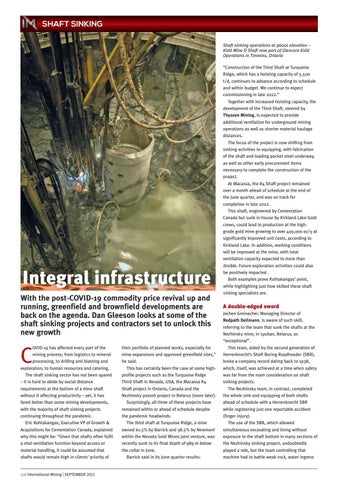SHAFT SINKING.qxp_proof 25/08/2021 12:48 Page 1
SHAFT SINKING Shaft sinking operations at 9600L elevation – Kidd Mine D Shaft now part of Glencore Kidd Operations in Timmins, Ontario
Integral infrastructure With the post-COVID-19 commodity price revival up and running, greenfield and brownfield developments are back on the agenda. Dan Gleeson looks at some of the shaft sinking projects and contractors set to unlock this new growth OVID-19 has affected every part of the mining process; from logistics to mineral processing, to drilling and blasting and exploration, to human resources and catering. The shaft sinking sector has not been spared – it is hard to abide by social distance requirements at the bottom of a mine shaft without it affecting productivity – yet, it has fared better than some mining developments, with the majority of shaft sinking projects continuing throughout the pandemic. Eric Kohtakangas, Executive VP of Growth & Acquisitions for Cementation Canada, explained why this might be: “Given that shafts often fulfil a vital ventilation function beyond access or material handling, it could be assumed that shafts would remain high in clients’ priority of
C
106 International Mining | SEPTEMBER 2021
their portfolio of planned works, especially for mine expansions and approved greenfield sites,” he said. This has certainly been the case at some highprofile projects such as the Turquoise Ridge Third Shaft in Nevada, USA, the Macassa #4 Shaft project in Ontario, Canada and the Nezhinsky potash project in Belarus (more later). Surprisingly, all three of these projects have remained within or ahead of schedule despite the pandemic headwinds. The third shaft at Turquoise Ridge, a mine owned 61.5% by Barrick and 38.5% by Newmont within the Nevada Gold Mines joint venture, was recently sunk to its final depth of 989 m below the collar in June. Barrick said in its June quarter results:
“Construction of the Third Shaft at Turquoise Ridge, which has a hoisting capacity of 5,500 t/d, continues to advance according to schedule and within budget. We continue to expect commissioning in late 2022.” Together with increased hoisting capacity, the development of the Third Shaft, steered by Thyssen Mining, is expected to provide additional ventilation for underground mining operations as well as shorter material haulage distances. The focus of the project is now shifting from sinking activities to equipping, with fabrication of the shaft and loading pocket steel underway, as well as other early procurement items necessary to complete the construction of the project. At Macassa, the #4 Shaft project remained over a month ahead of schedule at the end of the June quarter, and was on track for completion in late 2022 . This shaft, engineered by Cementation Canada but sunk in-house by Kirkland Lake Gold crews, could lead to production at the highgrade gold mine growing to over 400,000 oz/y at significantly improved unit costs, according to Kirkland Lake. In addition, working conditions will be improved at the mine, with total ventilation capacity expected to more than double. Future exploration activities could also be positively impacted . Both examples prove Kohtakangas’ point, while highlighting just how skilled these shaft sinking specialists are.
A double-edged sword Jochen Greinacher, Managing Director of Redpath Deilmann, is aware of such skill, referring to the team that sunk the shafts at the Nezhinsky mine, in Lyuban, Belarus, as “exceptional”. This team, aided by the second generation of Herrenknecht’s Shaft Boring Roadheader (SBR), broke a company record dating back to 1938, which, itself, was achieved at a time when safety was far from the main consideration on shaft sinking projects. The Nezhinsky team, in contrast, completed the whole sink and equipping of both shafts ahead of schedule with a Herrenknecht SBR while registering just one reportable accident (finger injury). The use of the SBR, which allowed simultaneous excavating and lining without exposure to the shaft bottom in many sections of the Nezhinsky sinking project, undoubtedly played a role, but the team controlling that machine had to battle weak rock, water ingress










